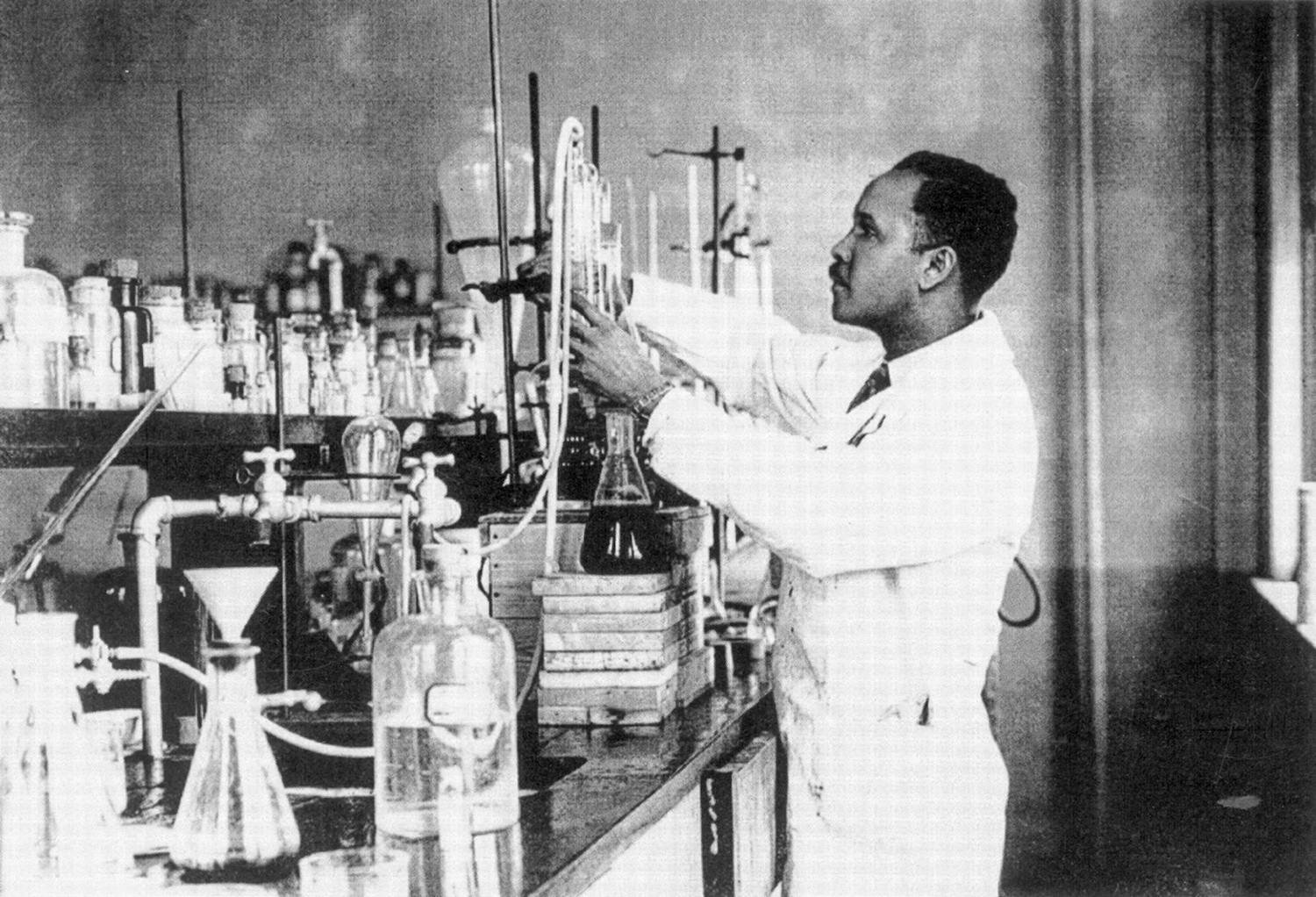
Surmounting the insurmountable
With unwavering perseverance, Percy Julian fought against segregation and other challenges to become a leading innovator in synthetic chemistry. His numerous inventions range from the fire retardant Aerofoam to treatments for glaucoma and rheumatoid arthritis. He was granted over 130 patents during his lifetime and was inducted into the National Inventors Hall of Fame in 1990. This year marks the 100th anniversary of Julian’s graduation, as valedictorian, from DePauw University. While that honor was the first of many intellectual and scientific accolades, Julian is equally celebrated as an innovator who broke down barriers for future scientists from underrepresented groups.
11 min read
Each month, our Journeys of Innovation series tells the stories of inventors or entrepreneurs whose groundbreaking innovations have made a positive difference in the world. This month, we are sharing in its entirety an article that originally appeared in Humanities magazine in 2007 under the title “Percy Julian: A scientist makes inroads in chemistry and civil rights.”
“It all began with a simple little bean,” Percy Julian wrote of the Calabar bean. “It was a beautiful, purple bean when I first got it. But it is not only beautiful in its appearance, but also in the laboratory it has within it.”
Julian was hungry for the deepest secrets of plant chemistry. His curiosity led him to pioneer the creation of drugs and other chemicals from substances previously found only in plants. His synthesis of physostigmine, found in the Calabar bean, or Physostigmavenenosum, yielded a treatment for glaucoma. From the soybean, he wrested a fire retardant used to douse gasoline fires on aircraft carriers during World War II; the soybean also became the foundation for hydrocortisone treatments for arthritis and for hormonal treatments. In his lifetime, Julian registered more than 130 chemical patents.
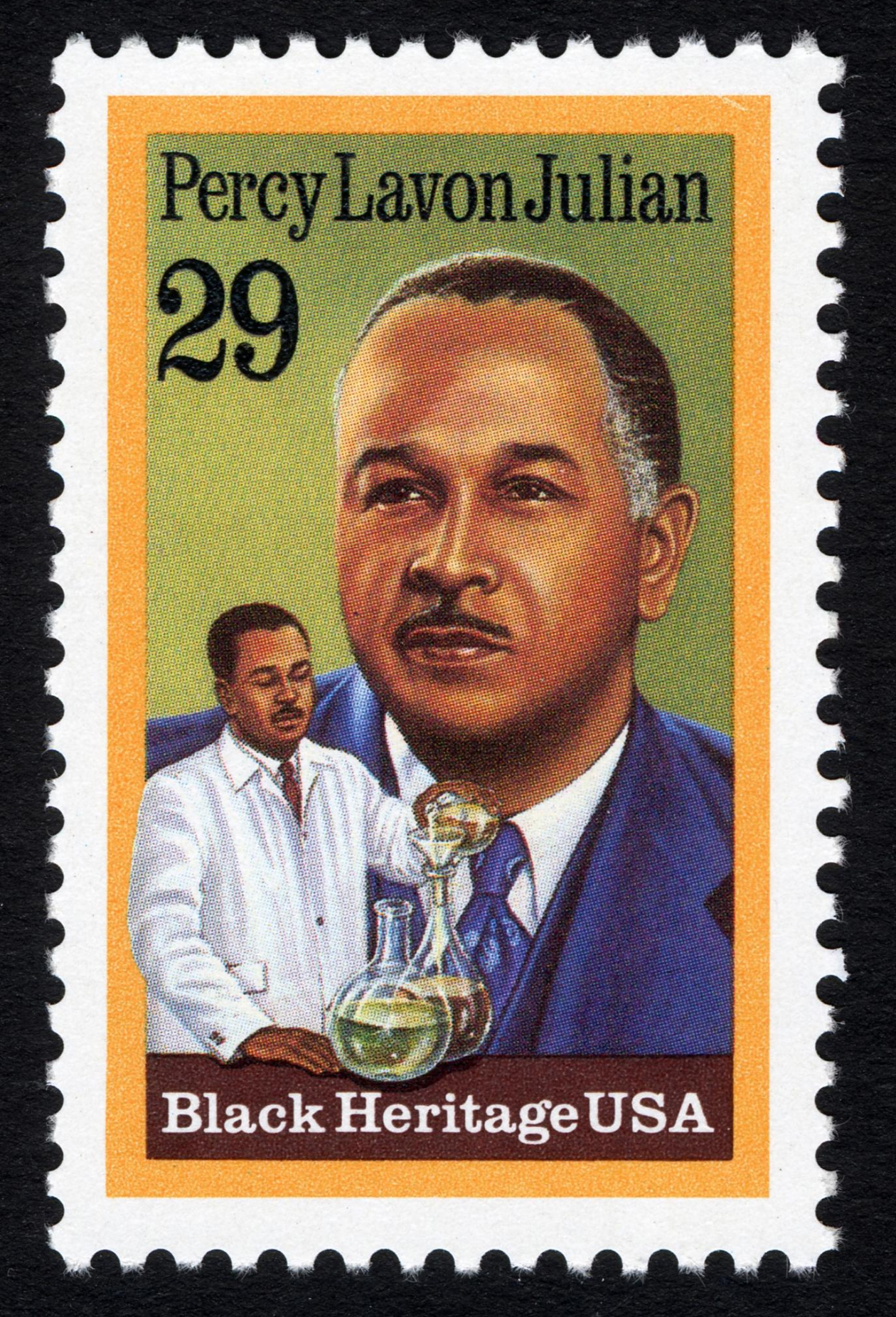
The United States Postal Service (USPS) released the Black Heritage stamp featuring Percy Julian in 1993. Barbara Higgins Bond, the artist responsible for the design, was the first African American woman to illustrate a USPS postage stamp. (Copyright United States Postal Service. All rights reserved.)
“It strikes me as the kind of science that an artist would do,” says Gregory Petsko, director of the Rosenstiel Basic Medical Sciences Research Center at Brandeis University. “He wanted to identify an organic compound that mattered, and then make it.”
In each of his many creations, Julian charted a path with a grace that became his signature: no wasted steps. Petkso, who considers Julian one of the best chemists of the twentieth century, describes his work as “clean.” “It’s elegant science,” he says. “That’s one of the highest praises you can give another scientist.” It took persistence for Julian to bring his talents to fruition. The grandson of former slaves, he struggled to receive an education and the access to laboratories that would make it possible for him to conduct research.
Forgotten Genius, a new NEH-funded film about Julian’s life, aired February 6 [2007] on PBS. While some in the scientific community knew of Julian’s achievement, his story was largely lost to the general public, says Stephen Lyons, one of the film’s producers.
“The drawback was, there was no biography,” says Lyons, who at the time was a senior editor for NOVA. So Lyons pieced together the personal dimensions of Julian’s story through clippings and a memoir by one of Julian’s colleagues.
Then, with initial support from the Camille and Henry Dreyfus Foundation, the film-makers cast a wide net and interviewed sixty family members, friends, and colleagues of Julian, who died in 1975.
As Julian’s story emerged, Lyons saw that it could show the issue of race in science and the obstacles it posed. Lyons points to Julian’s dogged persistence as a key to his personal triumph. With his refusal to accept a life without research, and his willingness to take risks, Julian made it impossible for the chemistry establishment to ignore him.
Julian was born in Montgomery, Alabama, in 1899, the first of six children. His parents were teachers; his father also worked as a railroad mail clerk. The Julians saved to create a family library for the children to use, and Percy worked hard.
Alabama’s educational system was segregated, and public school for blacks ended after eighth grade. Julian continued his education at a two-year teacher training school for black students before entering DePauw University in Greencastle, Indiana, in 1916.
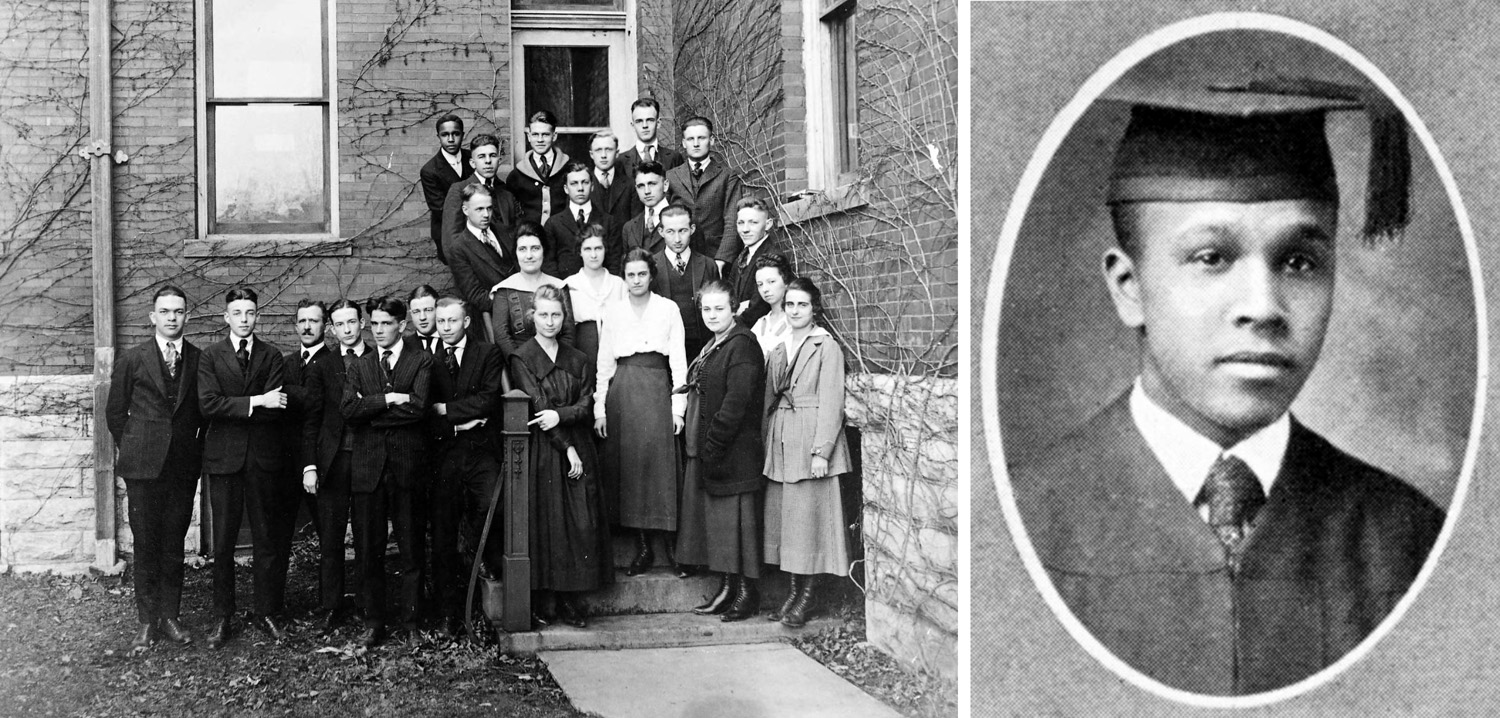
Left: Percy Julian (top center) in a 1918 DePauw University Science Club portrait. His advisor William Blanchard (bottom row, third from left) advocated for him throughout his academic career. Right: Julian graduated from DePauw in 1920 as class valedictorian and a member of the prestigious invitation-only Phi Beta Kappa honor society. (Images courtesy of DePauw University and the United Methodist Church.)
Getting into the university was just the start. Although DePauw had been educating black students since the Civil War, they were still segregated from many parts of university life. Unlike his white classmates, Julian received no dorm assignment. Instead, he was given a room away from campus with few furnishings and a slop jar for a toilet. His landlady told him she didn’t have to provide him with meals. Eventually, Julian found a place on campus. In exchange for a room, he waited tables and fired up the furnace in a fraternity house.
Julian attracted the notice of chemistry professor William Blanchard, whose enthusiasm allowed Julian to envision for himself a future in research, although only one African American had ever earned a doctoral degree in chemistry. Julian graduated from DePauw in 1920 at the top of his class. When he applied to Harvard University’s PhD program, the leading chemists there said that there was no point. Nobody would hire a black researcher. “Why don’t you find him a teaching job in a Negro college in the South?” they suggested to Blanchard. “He doesn’t need a PhD for that.”
Julian took the advice, and went to teach at Fiske University in Nashville. He eventually got to Harvard and received his master’s degree there, only to be thwarted again when he aimed for a doctorate that would allow him to pursue research.
He taught chemistry at several universities before getting Rockefeller Foundation support to pursue his doctorate at the University of Vienna in 1929.
In Vienna he studied alkaloids, plant chemicals that contain nitrogen. “Alkaloids were an untapped chemical class,” says Petsko, “and nature was full of them.” Chemists looked to natural compounds for potent medicines. Caffeine, morphine, strychnine—chemicals we now consider drugs—are plant alkaloids.
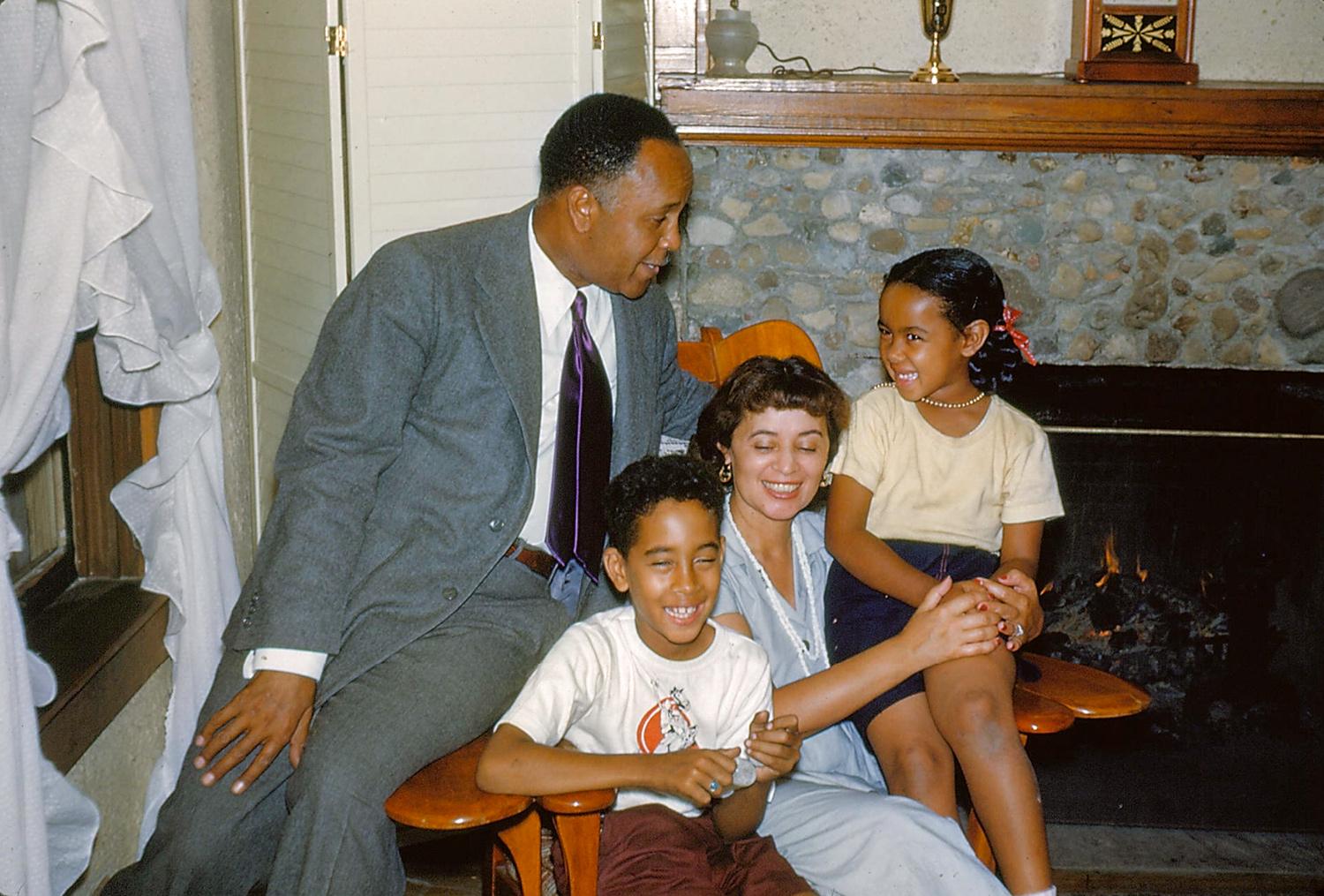
A snapshot from May 1950 features Percy Julian with his wife Anna Johnson Julian and their children, Faith and Percy Jr. (Image courtesy of DePauw University and the United Methodist Church.)
Julian specialized in synthetic chemistry, the creation of natural and new substances from the most basic chemicals. “Synthetic chemists are more artists than other types of scientists,” explains Petsko.
In Vienna, Julian also met a range of thinkers and contacts that would sustain him later, including Josef Pikl, his longtime research partner, and Abraham Zlotnik, a colleague who would play a key role in the success of Julian’s independent laboratory in the 1950s. The stimulation strengthened his resolve to pursue an intellectually ambitious career.
“For the first time in my life,” the thirty-year-old Julian wrote in a letter home, “I recognize that publications and research will be, for me, as natural a thing as going to bed and eating a meal.”
He returned to the United States in 1931 with his doctorate, intent on research. He married Anna Johnson, a professor of sociology from a prominent African American family in Baltimore, and they had a son and daughter. But his academic career was shadowed by politics at Howard University, and he soon found himself with no job.
With help from his old professor William Blanchard, Julian landed again at DePauw. He recruited Pikl as his research partner, and soon they were publishing results in the nation’s leading chemistry journals.
Julian’s breakthrough came in 1935 with his synthesis of physostigmine, which chemists previously found in the Calabar bean. A poisonous legume native to tropical Africa, the bean’s unusual properties had fascinated scientists since the 1800s. Physicians knew the drug helped to treat glaucoma, but they didn’t know how to get the large quantities they needed.
In choosing to synthesize physostigmine, Julian was challenging one of the foremost chemists of the day. Sir Robert Robinson had published widely on physostigmine and was working to synthesize the substance himself. Undaunted, Julian set out to get there first. With Pikl, he devised a different approach to creating the alkaloid. The two published articles on their progress, but the ultimate goal remained elusive.
As they were rushing to finish, Robinson published a complete synthesis. “The shock was almost unbearable,” Julian wrote of his reaction. “We were not the first, just the ‘me toos.’ Why did he, of so much fame, who didn’t at all need the glory, have to snatch the prize from us?”
Then Julian noticed a mistake in Robinson’s method. In their next paper, Julian and Pikl pointed out Robinson’s error and described their own synthesis. Julian knew that if he were wrong, his career would be finished.
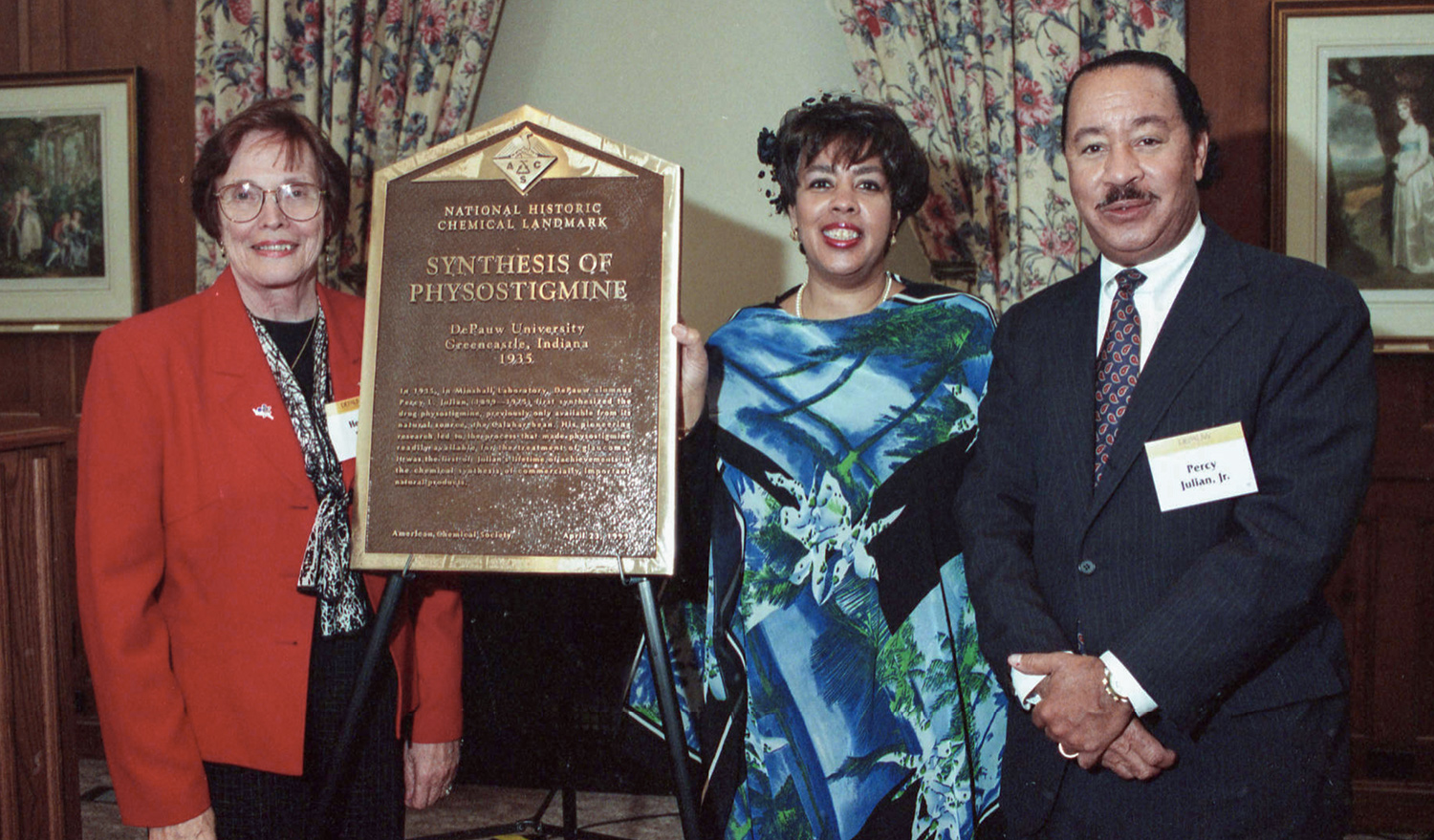
The American Chemical Society (ACS) presented a plaque honoring Percy Julian’s achievements in chemistry to DePauw University on April 23, 1999, during the university’s celebration of the 100th anniversary of Julian’s birth. From left: Helen M. Free (former ACS president and 2000 National Inventors Hall of Fame inductee), with Julian’s children, Faith and Percy Jr. (Image courtesy of DePauw University and the United Methodist Church.)
In the end, Julian’s analysis held up and his own synthesis of physostigmine was confirmed. In 1999, the American Chemical Society named his work on physostigmine a National Historic Chemical Landmark, calling it “the first of Julian’s lifetime of achievements in the chemical synthesis of commercially important natural products.”
Julian’s triumph with physostigmine made him a major figure in chemistry research. But even with that great discovery, his career was not secure. He was soon forced to leave DePauw after local critics challenged the school for hiring him. He sought other positions but no one would employ him because of his color.
“Day by day, as I entered these firms, presented my credentials and asked for a job, the answer seemed like it had been transmitted by wire from one firm to another,” he recounted later. Every company he approached said it had never hired a black research chemist before and didn’t know how to do it now.
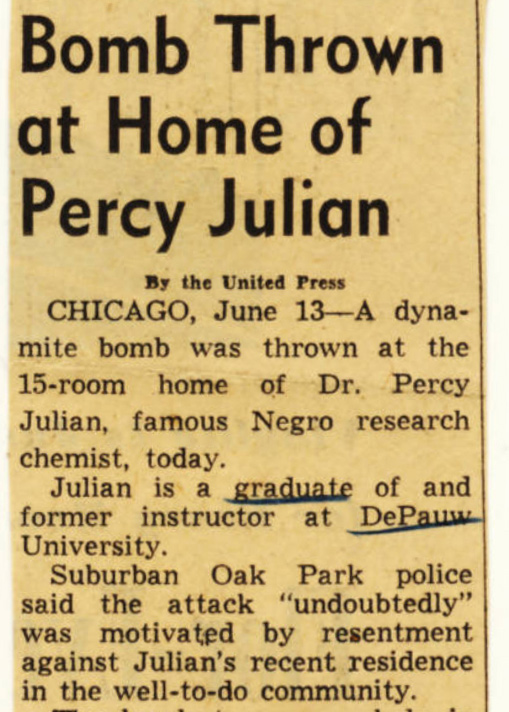
A newspaper article from June 1951 details the second attack on Percy Julian’s suburban Chicago home. (Image courtesy of DePauw University and the United Methodist Church.)
He was eventually hired by the Glidden Company to direct research at its new soy products division. “And so I came to Chicago and started in on another fascinating plant, the soybean,” he said. At Glidden, Julian isolated soybean derivatives that, on an industrial scale, would be used in everything from paper coatings and paint to foods and the fire retardant “Aerofoam,” which the Navy dubbed “bean soup.” Julian’s soy protein would also become a crucial ingredient in latex house paints, which made millions of dollars for Glidden. On the medical side, Julian found ways to make artificial sex hormones.
Despite the advances that Julian had made in steroids, Glidden wanted him to focus on paint and industrial products. The company balked at his plans to pursue further biomedical work with the soybean, so Julian left to start his own company in 1953.
Using chemicals from plants, he continued to find ways to create new hormones to treat human ailments on the scale required for mass production. “He did it first, and he did it in a way that made it possible for other researchers” to take hormone research further, says Petsko. “It effectively opened up an area of medicine. That was a huge achievement.”
In 1950, Julian’s professional success allowed him to buy a house in the Chicago suburb of Oak Park. As they prepared to move, Julian’s wife and ten-year-old son arrived to find that someone had attempted to burn the house down. A homemade gasoline bomb had been planted by arsonists opposed to a black family in the all-white suburb.
He and his family resolved not to leave. “Anna and I felt we had no choice but to stay,” Julian wrote. “The right of a people to live where they want to, without fear, is more important than my science.”
“They were simply not intimidatable,” Percy Julian Jr. says of his parents. The senior Julian helped create social progress by hiring scientists of color in his company. Later in his life, Julian spoke out against the unacceptable barriers that racism created.
“I feel that my own good country robbed me of the chance for some of the great experiences that I would have liked to live through,” said Julian. “Instead, I took a job where I could get one and tried to make the best of it. I have been, perhaps, a good chemist, but not the chemist that I dreamed of being.”
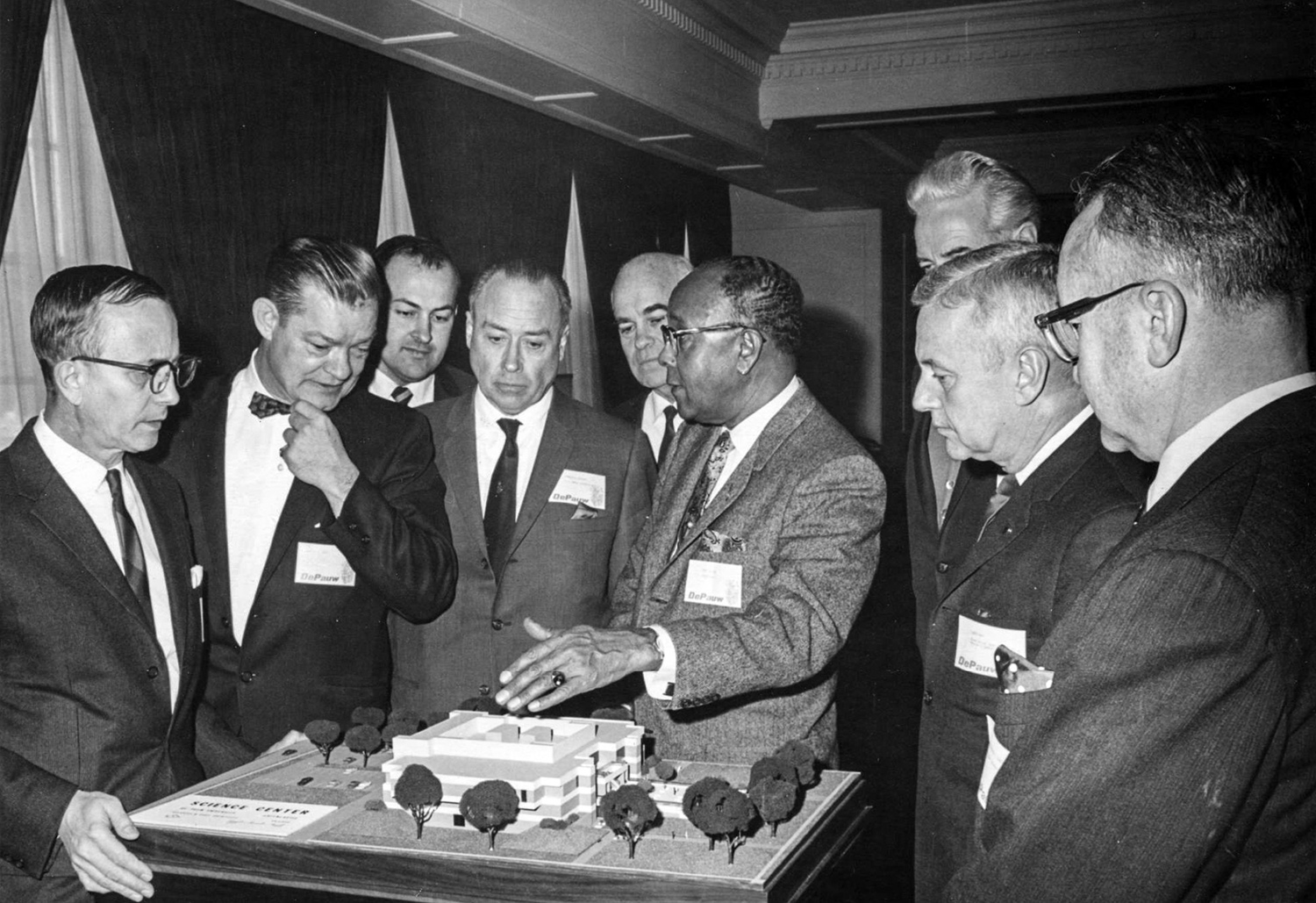
Percy Julian (center) and DePauw University faculty and staff discuss a model of the university’s Science and Mathematics Center circa 1967. Julian gave keynote remarks at the building’s opening ceremony in 1972. It was renamed the Percy L. Julian Science and Mathematics Center in 1980 and was expanded and rededicated in 2003. (Image courtesy of DePauw University and the United Methodist Church.)
“His story is a story of great accomplishment, of heroic efforts and overcoming tremendous odds,” says University of Illinois historian James Anderson in the film. “It’s a story about who we are and what we stand for, and the challenges that have been there, and the challenges that are still with us.”
Petsko echoes this sentiment. “How many other Julians are there who aren’t doing what he did, simply because they don’t have the opportunity? It makes me wonder if we’re trying to solve 100 percent of the world’s problems with less than 100 percent of the world’s brainpower.”
Credits
Reproduced by the USPTO Office of the Chief Communications Officer. For feedback or questions, please contact inventorstories@uspto.gov.
Story by David Taylor. Contributions to the reproduction from Jay Premack, Marie Ladino, Joyce Ward, Jeff Isaacs, and Eric Atkisson.
The image at the beginning of this story features Percy Julian working in the Minshall Laboratory at DePauw University during his tenure as a research fellow there. (Image courtesy of the Historical Society of Oak Park and River Glen.)
References
David Taylor, “Percy Julian: A scientist makes inroads in chemistry and civil rights,” HUMANITIES 28, no. 1 (January/February 2007): https://www.neh.gov/humanities/2007/januaryfebruary/feature/percy-julian.
National Inventors Hall of Fame, “Percy Lavon Julian,“ https://www.invent.org/inductees/percy-lavon-julian.



